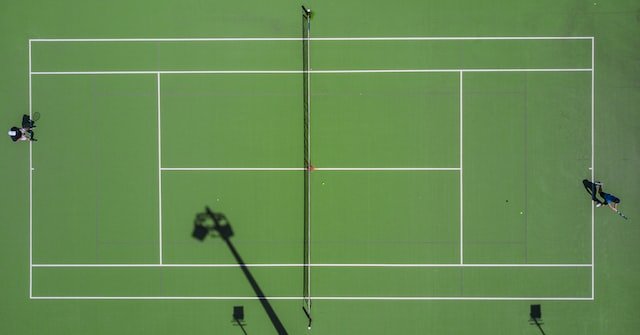Tennis is a game of inches and it is important to understand the full dimensions of a court, whether you are playing or looking to build your own tennis court. So without further ado let’s look at the tennis court layout and understand the tennis court dimensions in full.
What are the dimensions of a standard tennis court?
The length of a tennis court is 23.77 meters. However, the width of a tennis court varies with the game’s nature. The singles court is 8.23 meters wide, while doubles matches happen on courts 10.97 meters wide. Meanwhile, the center service line is 6.4 meters from the net.
What is a tennis court’s total area?
The court surface for doubles tennis is 260.87 square meters, corresponding to the entire playing surface. In contrast, the playing area for singles matches is 195.65 square meters.
What is the Size of a tennis court in feet
The entire court is 78 feet long, while the service line is 21 feet from the net. The court area for singles play is 27 feet wide, while the doubles court is 36 feet wide. The total area of a tennis court for singles matches is 2106 square feet, and 2808 square feet for a doubles game.
Dimensions of a tennis court in yards
The side of the court is 26 yards long, while the service line is seven yards away from the net. The court for singles matches is nine yards wide and 12 yards for doubles matches. The tennis court area for a singles game is 234 square yards. Meanwhile, that number goes to 312 square yards for doubles play.
How big is the court for singles tennis matches?
The playing area for singles matches is 23.77 meters (78 feet or 26 yards) long and 8.23 meters (27 feet or nine yards) wide. Those numbers correspond to 195.65 square meters (2106 square feet or 234 square yards).
How big is the court for doubles matches?
The playing area for doubles is 23.77 meters (78 feet or 26 yards) long and 10.97 meters (36 feet or 12 yards) wide. Those numbers correspond to 260.87 square meters (2808 square feet or 312 square yards).
Do all tennis courts have the same size?
Professional courts used by the International Tennis Federation, Women’s Tennis Association, and the Association of Tennis Professionals follow the standard size. However, courts for touch tennis, pickleball, and recreational play may be played in smaller courts. The courts used for singles and doubles matches follow the dimensions mentioned above but differ in markings to indicate their corresponding play area.
Why are there box areas in a tennis court?
These boxes indicate the various areas used in a game. There are two service boxes near the tennis net: the deuce service box and the advantage service box. Each service box is 6.4 meters (21 feet/seven yards) long and 4.11 meters (13.5 feet/4.5 yards) wide. They are named to indicate where the server must position during a deuce (40-all) or an advantage. The deuce box is on the right-hand side of the court, while the advantage box is on the left-hand side. The center service line separates these two boxes.
Meanwhile, the so-called No Man’s Land is the largest box on the tennis court, referring to the space between the service line and the baseline. It got its name from the difficulty of winning a point from that area. There are also tramlines or double alleys at the sides of the court. This area is an additional space for doubles matches, and they are 1.37 meters (4.5 feet/1.4 yards) wide on both sides.
Net height and dimensions
The height of the net is 1.07 meters or three feet, six inches at the posts, and 0.91 meters or three feet at the center. Meanwhile, the net posts are 0.91 meters or three feet away from the singles or doubles sideline. The varying height prompts players to adjust the angle and the execution of their strikes depending on where they want to send the ball.
How much space is needed for a tennis court?
A standard court needs at least 36.58 by 18.29 meters (120 by 60 feet, 40 by 20 yards) of space or 668.9 square meters (7,200 square feet or 2400 square yards). Meanwhile, a tournament court requires 39.62 by 21.34 meters (130 by 70 feet, 43.3 by 23.3 yards) of space, or 845.2 square meters (9,100 square feet or 3033.3 square yards). The additional space is for umpires and players to have enough room if chasing a ball down. Based on the numbers, an acre of land is enough space for six standard or four tournament courts.
How broad are the court lines in the game of tennis?
The baseline must be at least four inches wide, while the other lines must be at least two inches wide. Following these measurements is crucial because the ball is in as long as a portion of it lands on the line. The Hawkeye technology has made making the right line calls easier by using more than one camera angle to determine the ball’s trajectory.
Aside from the baseline, the sideline, and the center service line, there’s also a center line (sometimes referred to as a center mark) which is a small mark attached to the baseline. It separates the deuce court from the advantage court and runs straight with the center service line.
How high is an indoor tennis court?
An indoor court must be at least nine meters above the net line. Meanwhile, the ceiling must be 5.75 meters (18.8 feet/6.2 yards) above the baseline and four meters (13.1 feet/4.3 yards) above the distance behind the baseline, also known as run back. There must be no obstructions in these spaces.
What’s the best surface for a tennis court?
Tough question.. The answer depends on what type of surface you are comfortable and enjoy playing. Grass courts speed up the game and suit a serve and volley game, while a clay court renders the tennis ball on a slower tempo but with higher bounces. The hard court (concrete courts) is a mix of the two and is low maintenance. In terms of grand slams, the Australian Open and the U.S. Open use hard courts. The French Open, formally known as Roland Garros, uses clay courts. Finally, the Wimbledon Championships are played on grass courts. My personal preference is to play on a grass court, I like the speed and the fact I get a chance to serve volley. I also like the fact that this is only played for a few months a year and is deemed a specialist surface.
Final Thoughts
Whilst the dimensions of a tennis court are broadly the same, it is fantastic that players get to challenge themselves on different surfaces, whether grass or indoor carpet.
If you are looking to build a new backyard tennis court you will need to think about the space around the court so you can give yourself room to move and play. When building a new tennis court seek an expert opinion from tennis court builders also as this is not something you can just build in your spare time.
Our advice is to get out and play on as many courts as possible in order to develop your game further.







Comments are closed.